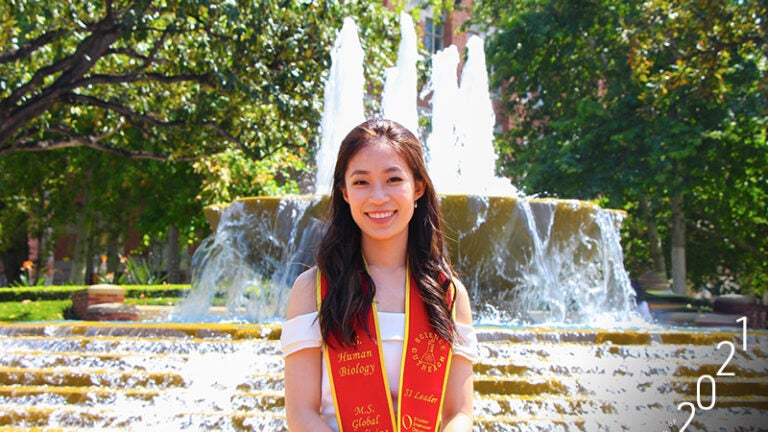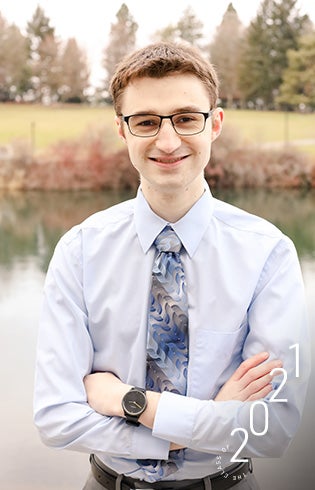
The USC Student Symphony Orchestra didn’t let COVID-19 stop the music
Musicians have a reputation for devotion to their craft, sometimes in the face of catastrophe. The house band of the Titanic, for example, famously played as the ship sank.
When the COVID-19 pandemic slashed through Los Angeles in 2020, shuttering businesses and forcing schools to conduct courses online, the USC Student Symphony Orchestra (SSO) stopped meeting in person but, in a similar spirit of resilience, kept the music playing.
Since the start of shutdowns, the orchestra has produced multimedia recordings of over 50 pieces, including Camille Saint-Saëns’ Carnival of the Animals suite, Mary Lou Williams’ Zodiac suite and a fall concert that highlighted music of the African diaspora. Their final concert of the year, which honored the group’s 10th anniversary, included two world premieres and a collaboration with the Thornton Jazz Orchestra.
These efforts were led by violinist Elaine Huang, the orchestra’s president, who graduates May 14 with a degree in human biology from the USC Dornsife College of Letters, Arts and Sciences. Keeping the group alive during quarantine was important for Huang in her last year at USC.
“It’s really the friends that I’ve made through orchestra, and whom I shared musical experiences with, that enriched my collegiate experience,” says Huang. “What I enjoy most about music is that it’s meant to be shared with others.”
Orchestrating friendship
Huang started playing the piano when she was five and then picked up the violin. She grew up playing alongside her two younger sisters, who also play violin and piano. Although she wanted to continue her music in college, her primary focus at USC Dornsife was her path to medical school.
This made SSO the perfect fit. The orchestra formed in 2011 by students who wanted to perform classical music but who couldn’t join USC’s official symphony as they weren’t music majors. Thornton students, who wanted a chance for more leadership opportunities outside the official symphony, also joined.

Graduating senior Aaron Ghrist heads to Stanford University this fall for a Ph.D. in applied physics. (Photo: Courtesy of Aaron Ghrist.)
For Aaron Ghrist, who graduates this year from USC Dornsife with a dual degree in mathematics and chemistry, finding the group was a welcome reprieve from attempting to practice the trumpet in his dorm room.
“I wasn’t allowed to use practice rooms [at the USC Thornton School of Music], so I needed another outlet to play,” says Ghrist, who earned a Goldwater Scholarship in 2020. “After sitting in on my first rehearsal and auditioning [for SSO], I never looked back.” Ghrist is now the orchestra’s manager.
Some 70% of the symphony’s members are not music majors, says Huang. The group includes students from every school at USC, and its academic diversity provides an excellent opportunity for cross-discipline friendship.
“The friends I’ve made encouraged me to take other classes beyond my normal biology courses,” says Huang. She’s tried an organ performance and introductory conducting class, thanks to their suggestions.
Adaptation and collaboration
When the pandemic prevented in-person gatherings, technology stepped in to keep musicians connected. Click tracks, which provide musicians with a tempo to follow, let players keep time as they play. After they’ve recorded their parts, the group used Zoom to listen to each piece and then brainstorm changes.
“We play the music and then people drop visual ideas into the chat and say, ‘Oh, I think this would be really cool to do here,’” says Huang.
Virtual performances have enabled unconventional collaborations. Students from the USC Roski School of Art and Design and the USC School of Cinematic Arts turned the videos into playful visual presentations. In a performance of Joseph Bologne’s Violin Sonata No. 1, a violinist and pianist play in a field of flowers as petals drift past. Later, other musicians float upwards in hot air balloons.
For Saint-Saëns’Aquarium, SSO teamed up with the Aquarium of the Pacific in Long Beach, California, to blend videos of fish, seals and crustaceans with footage of musicians. Dancers from the USC Glorya Kaufman School of Dance glided along to Saint-Saëns’ The Cuckoo in the Depths of the Woods.
“Since this our 10th anniversary season, we wanted to make it as special as possible to commemorate all of these things that this organization has been able to accomplish,” says Huang.
Playing power
Persevering through the pandemic gave the orchestra a chance to respond to societal issues thrown into the spotlight this year.
SSO recorded the 12 movements of Mary Lou Williams’ jazz Zodiac Suite. Williams, a Black woman from Pennsylvania, began her music career under the shadow of racism — giving piano concerts to her white neighbors persuaded them to stop throwing bricks into her family’s house.
Their fall concert was a tribute to the compositions of Black musicians, who are often overlooked in the classical music world.
“This year has been a long-overdue response and reflection on the social injustices that have occurred,” says Huang. “We’re hoping that by producing these works we’re able to highlight some of these pieces that have not received as much attention.”
With SSO videos now garnering tens of thousands of views on YouTube, playing through a pandemic may have paid off with an even larger audience when they return to live performances.